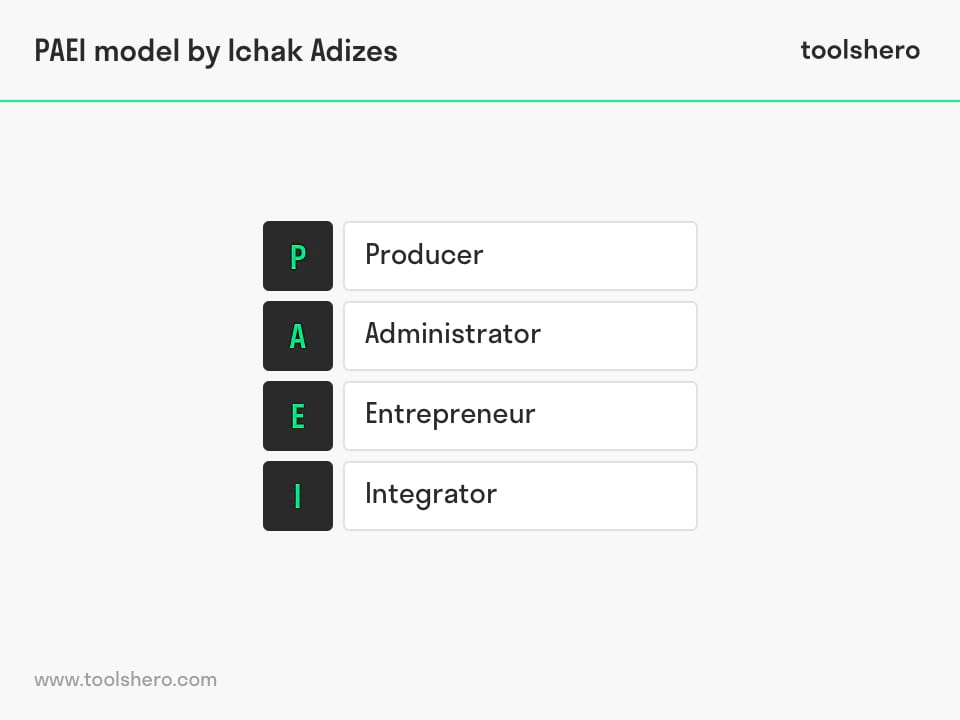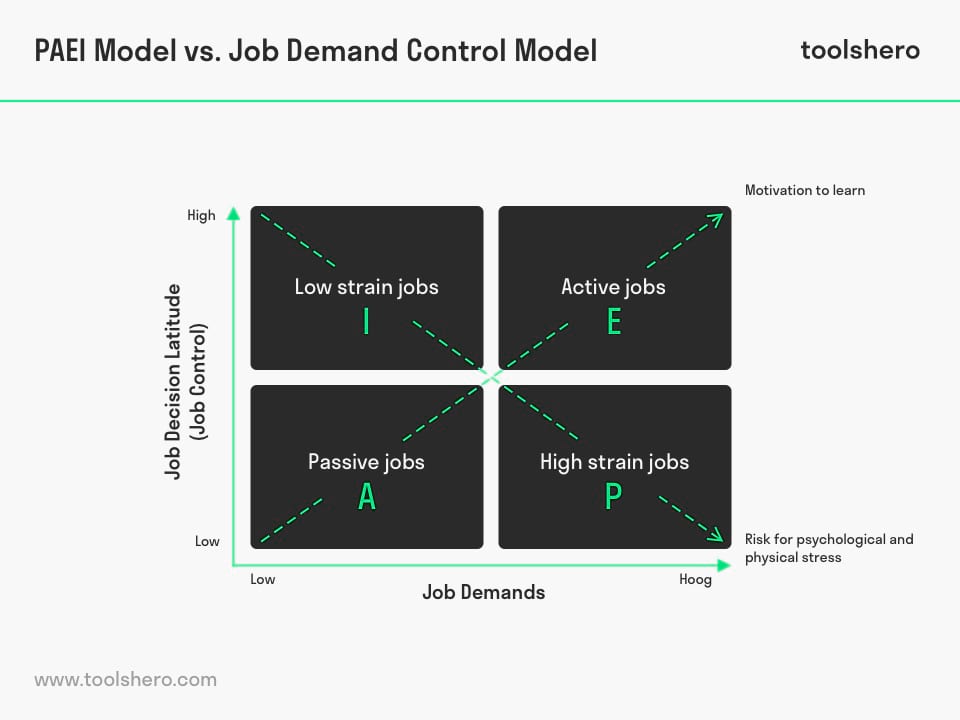PAEI Model by Ichak Adizes

PAEI Model: this article explains the PAEI Model, developed by Ichak Adizes in a practical way. Next to what it is, this article also highlights four important roles and the application of this management model. After reading you will understand the basics of this management tool. Enjoy reading!
What is the PAEI Model?
The PAEI Model by the American dr. Ichak Adizes (1979) describes four important roles that together make up a successful management team.
Ichak Adizes is one of the leading management experts in the world. The PAEI Model is an acronym that stands for Producer, Administrator, Entrepreneur and Integrator (PAEI).
Explanation of the PAEI Model
Below, you will find a short explanation per management role:

Figure 1 – PAEI model (adizes)
PAEI Model: the Producer
The main goal of any organisation is working towards and achieving results. The producer feels particularly responsible for the final product or service that is delivered to the customer. In addition, he is ultimately responsible for achieving the objectives.
Produces often work fast and have a tendency to focus on the end-result. They are hard workers and tend to put a lot of time pressure on their employees.
Producers are very ambitious. The final product has to meet the expected results and the producer and his team work very hard to make that happen.
Administrator
An administrator focuses on how tasks are completed and therefore keeps a close eye on the work process. He checks is everything is done according to rules and procedures. He has strong analytical skills and a structured approach, and he develops systems to work efficiently and productively.
Administrators are mainly interested in rules and policy measures and focus on correctly following procedures. They have an often slow but steady and structured approach to problem solving and decision making.
Organisations depend on administrators for developing processes and systems that ensure that everyone works efficiently and productively. Administrators often work in accounting or other process-oriented departments.
Entrepreneur
The entrepreneur is very industrious and full of ideas. He has a sharp vision for the future and is capable of taking calculated risks.
His or her strategic insight makes him well suited to distinguish between opportunities and threats to the organisation and able to see which strategy is best for the organisation and which new markets offer opportunities.
Entrepreneurs do not avoid unstructured approaches to problem solving and decision making. Entrepreneurs and entrepreneurship can mostly be found in senior management position or in marketing, research and development teams.
Integrator
The integrator brings people together and is the beating heart of a team or within an organisation. He is capable of creating harmony within a group. His focus is on the process and not so much on the end-result. The integrator is emotionally intelligent and empathic and knows how to build trust and respect in a team.
The integrator’s goal is to solve problems and he tends to work slowly and methodically in order to focus on the process. He has a friendly leadership style and always takes time to help others and listen to their stories.
Integrators can play an important key role in the building of a corporate culture.
Stress Management: 40+ easy ways to deal with stress
Stress relief and burnout prevention. Don’t let stress control your life. Beat anxiety and worries. Live, Laugh, Love.
PAEI Model: stress management categories
Work stress and tension can be described as strain. Strain can be high or low. In addition, there is always the matter of decision making freedom and control and self-managing that is described with latitude. Latitude can also be high or low.
When combined with the management roles of Producer, Administrator, Entrepreneur and Integrator (PAEI), that creates four stress categories for jobs, which are similar to Karasek’s Job Demand Control.

Figure 2 – PAEI model versus Job Demand Control
P – Stressful jobs (low latitude – high strain)
High job demands and little room for controlling one’s own work lead to a stressful job. In his management role, the Producer takes up a lot of responsibility, which brings with it some tension, without him looking for extra space to be able to organise his time himself.
The Producer enjoys the workload, which is often experienced by others as being excessive. Of all the roles, these are the jobs with the highest strain, which the Producer actually enjoys.
A – Passive jobs (low latitude – low strain)
The combination of low strain and very little latitude lead to a passive job. The Administrator is the management role that fits best with these types of jobs. The Administrator strives to manage issues through the implementation of processes and regulations.
By following procedures, the Administrator does not feel the need to widen his decision-making latitude. It is the procedure that ensures that things run smoothly and that potential problems are solved quickly. That is what gives him satisfaction.
E – Active jobs (high latitude – high strain)
The combination of high strain and high latitude creates challenging work and leads to active jobs. The Entrepreneur is the management role that fits perfectly with this type of job. This combination leads to feeling challenged in the workplace. That creates room for development and growth.
Active jobs are not stressful to Entrepreneurs because they choose them and need the high demands in order to function actively. Because they have control when it comes to their job, they experience a significant sense of freedom. That helps motivate them even more, which they pass on to the team.
I – Low-stress jobs (high latitude – low strain)
The combination of low strain and high latitude ensures relaxed work that translates into stressless jobs. The Integrator is the management role that is often found in these jobs. In these types of jobs, the social processes are very important.
The Integrator has the time to participate and ensure that everyone feels part of the team. The danger of this job is that the combination of a high degree of latitude and simple work can lead to feeling bored. The Integrator would be well-advised to focus on the atmosphere in the group and to give attention to all the individuals.
Application of the PAEI Model
No one can fill all these roles at the same time. A management team becomes strong and effective when different managers each play a role.
The PAEI Model can also be used as a tool for self-reflection.
It will make a manager better able to understand his strengths and weaknesses and understand what is preferred style is that suits him best. That way, he will be better able to identify with his management role and that will help him to identify his weaknesses and work on them.
In addition, the PAEI Model is a useful tool to put together a new management team. By bringing together a diverse group of people, they will work together more effectively, which will make it easier to achieve the objectives. A practical way to put a team together is to first determine which expertise and skills are important.
Based on that information, you can then bring together the right people, using the roles of Producer, Administrator, Entrepreneur and Integrator. By ensuring that each role is represented by at least one person, the team will flourish.
It’s Your Turn
What do you think? Can you apply PAEI Model in today’s modern business companies? Do you recognize the practical explanation or do you have more suggestions? What are your success factors for people and stress management?
Share your experience and knowledge in the comments box below.
More information
- Adizes, I. (1979). Organizational passages—diagnosing and treating lifecycle problems of organizations. Organizational dynamics, 8(1), 3-25.
- Adizes, I. (1979). How to solve the mismanagement crisis: Diagnosis and treatment of management problems. The Adizes Institute Publishing.
- Smith, C., Jennings, C., & Castro, N. (2005). Model for assessing adaptive effectiveness development. Journal of Contingencies and Crisis Management, 13(3), 129-137.
How to cite this article:
Mulder, P. (2017). PAEI Model (Adizes). Retrieved [insert date] from Toolshero: https://www.toolshero.com/management/paei-model/
Original publication date: 12/13/2017 | Last update: 12/25/2023
Add a link to this page on your website:
<a href=”https://www.toolshero.com/management/paei-model/”>Toolshero: PAEI Model (Adizes)</a>












